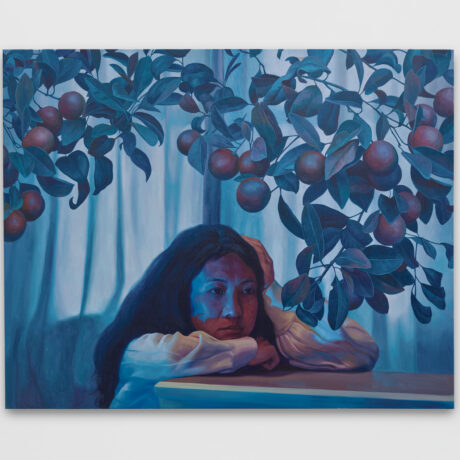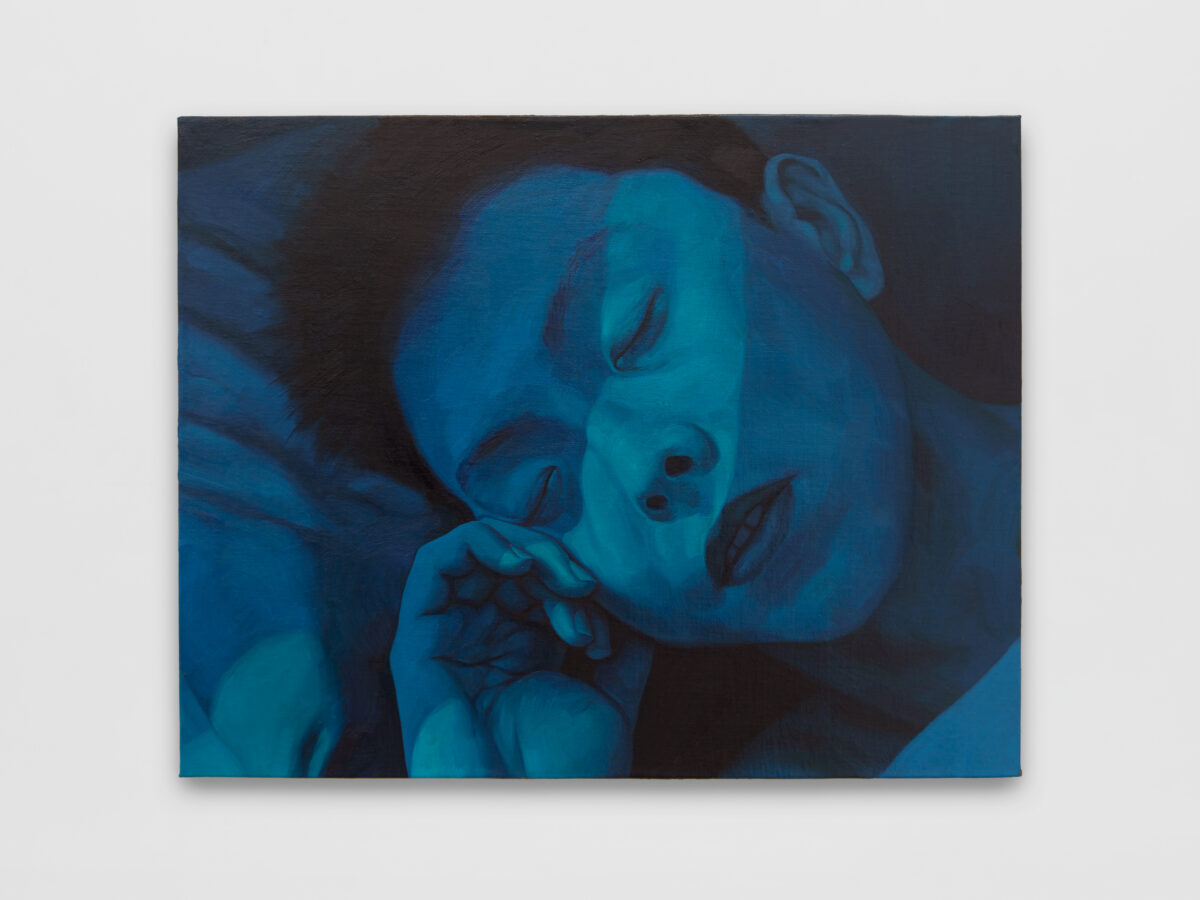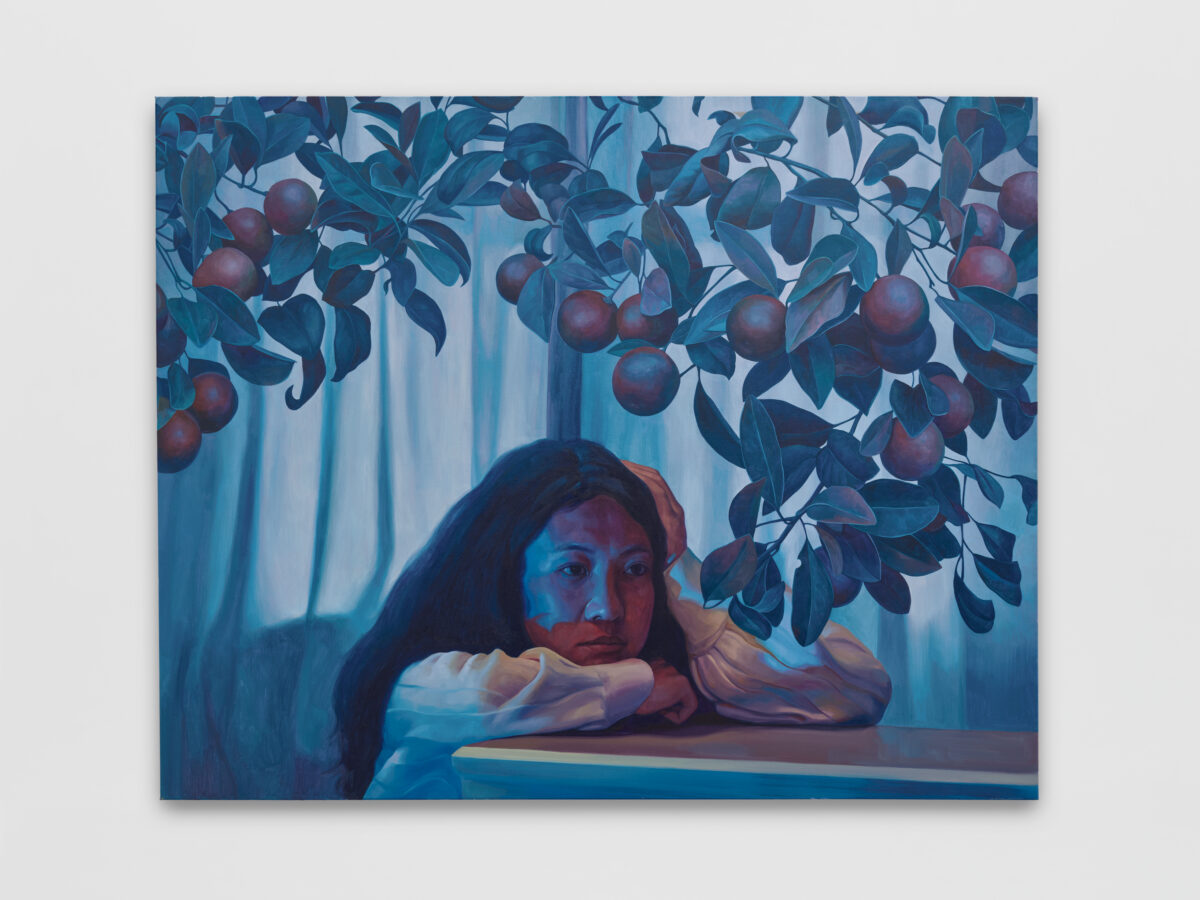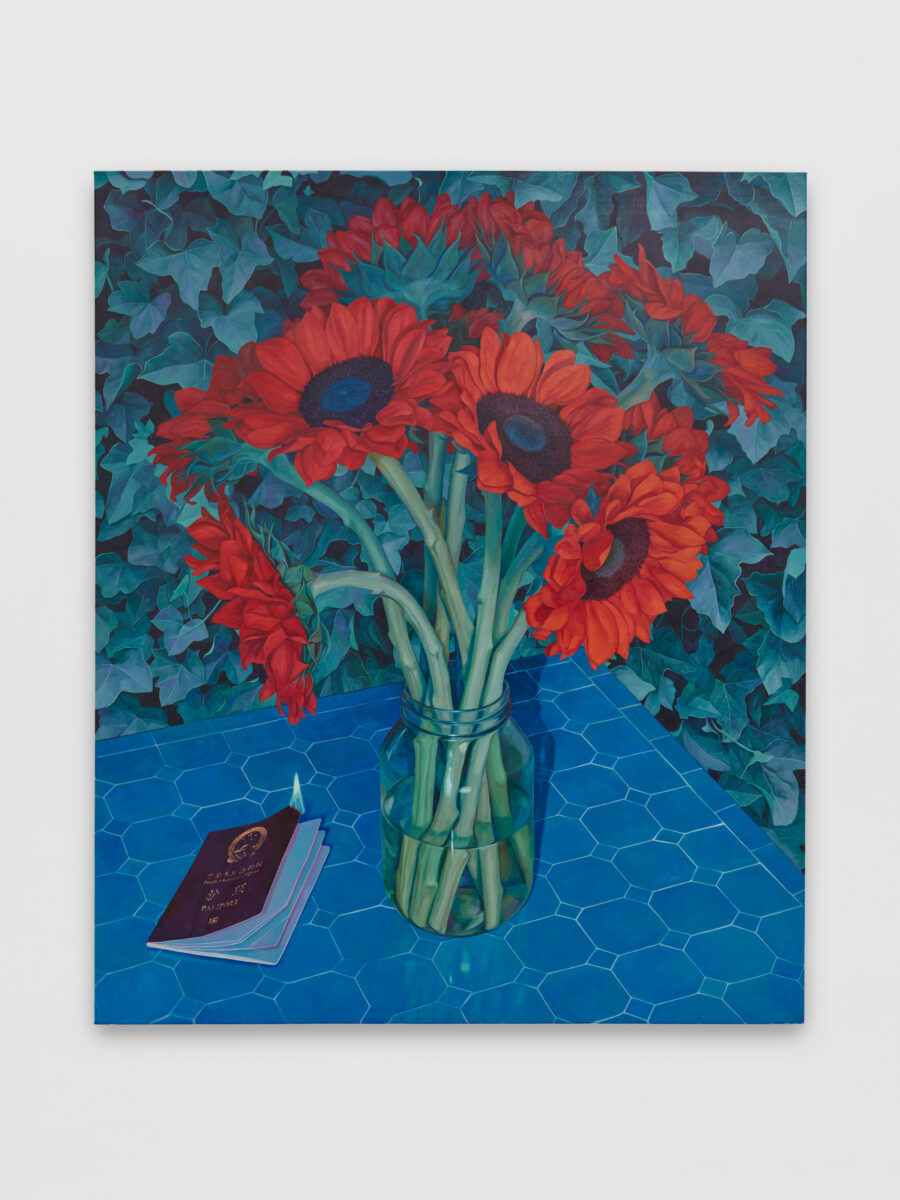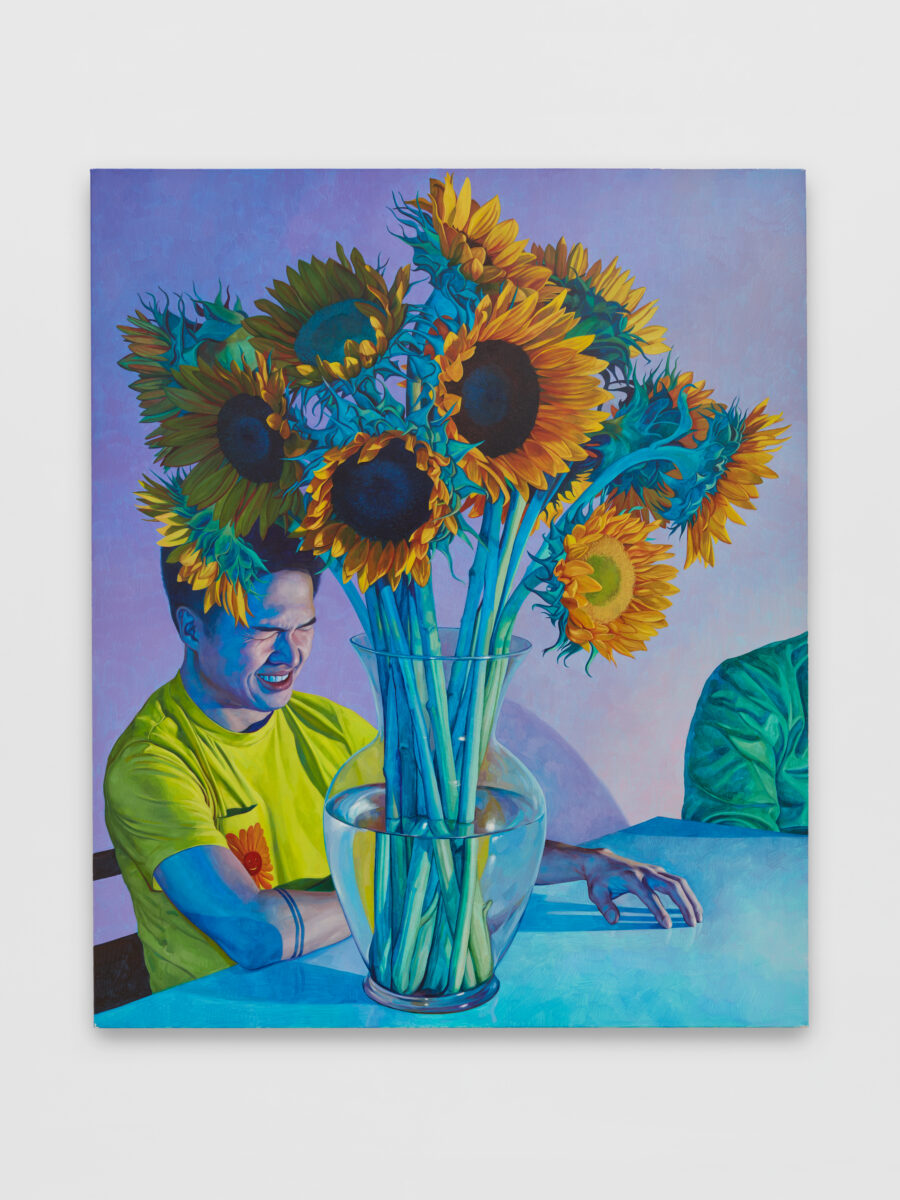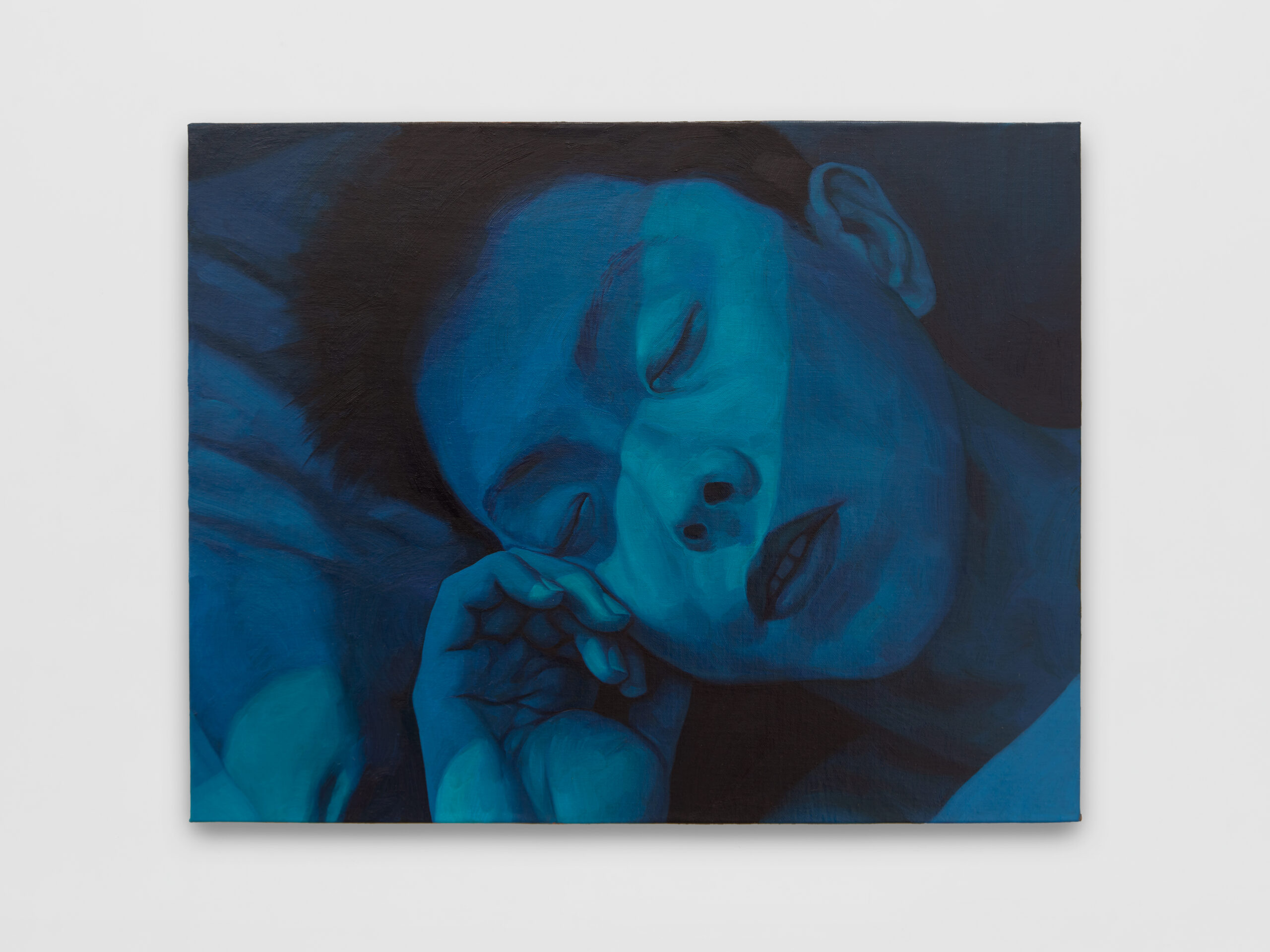
London – With remarkable technical ability, Xiao Wang creates almost photo realistic depictions of human beings with intensely expressed emotions, masterfully constructed objects and lush plant life. The attention to atmosphere and tonality however, is what pushes these paintings away from the known and into a more abstract space.
A key tool in Xiao’s box is the deployment of beguiling hues, most often centred on a cool, weighty blue. Though veering away from unifying narratives, an effect of this is that his paintings are all projections from the same metaphysical place, one imbued with the supernatural and dreamlike. These concepts carry an idea of limitlessness – the endless possibility of dreaming minds, and lawless unreality, to reach inexplicable levels of fantasy. Xiao’s work is however tethered to the real world, with the lives of human beings woven into the rope.
Xiao spent some moments talking to Daniel Mackenzie about his work, and in the process revealed details of his use of technology and influences, and a deep interest in David Lynch.
His work is currently exhibited with PM/AM at 37 Eastcastle Street in Central London coming to a close on 19th September.
“These concepts carry an idea of limitlessness – the endless possibility of dreaming minds, and lawless unreality, to reach inexplicable levels of fantasy.”
Daniel Mackenzie: Your work communicates quite immediately the idea of a surreal or metaphysical world that lies beyond, or perhaps parallel to, our own. I’m interested to know how much of this is purely an aesthetic, or what substance there could be to this.
Xiao Wang: When I think about my work, originally around six or seven years ago I had this interest in the history of Romanticism, and that was where my interest started. I was working on a lot of landscapes for a while, and then I had more and more interest in figures. So I was working out figures and then over time these two started to merge, which led to where my work is at the moment. Any kind of metaphysical reference for me is rooted in Romanticism, in a way that I think the idea of Romanticism originally was, and how I find my place in it, how my identity fits into this tradition and history.
DM: It’s interesting to learn how much of a strong link you have to Romanticism given how your work isn’t only very contemporary in its overall aesthetic, but through your use of digital technology in the painting process. So your work sits between traditional and innovation in quite a few ways.
XW: Well in my earlier background, I was trained in a very academic way in China, and to a point I really just wanted to get away from that for a while. I don’t think I was fully comfortable painting realistically until after grad school, but I did end up making peace with that experience. I decided I think it’s okay for me to paint in a Realism style again, but I’m not comfortable going back to what I was doing before. So there has to be a way to reinvent the style for myself. For me that is being honest with the subject and true to the subject matter but also from a compositional and technological standpoint, to do something new.
DM: For sure, it sounds like the modern way. Has your use of technology helped inform what is a very particular colour palette? What’s the symbolism or the significance of using blue in many of your paintings?
XW: The blue and green and purple – these kinds of unnatural colours – developed gradually. Originally I wasn’t thinking about what colour I would want to use in my painting, or too much about the symbolism of these colours. I was thinking about how to distort colours to an extent that they are as unnatural as possible, and that was my goal. I didn’t want to do landscape paintings using a naturalistic colour palette, so I did a lot of modification to the imagery and the raw materials to get to a point that they are as alien as possible, but still keeping the form. Over time they sort of landed on this blue, greenish and magenta colour palette. It’s the opposite of the naturalist colour palette.
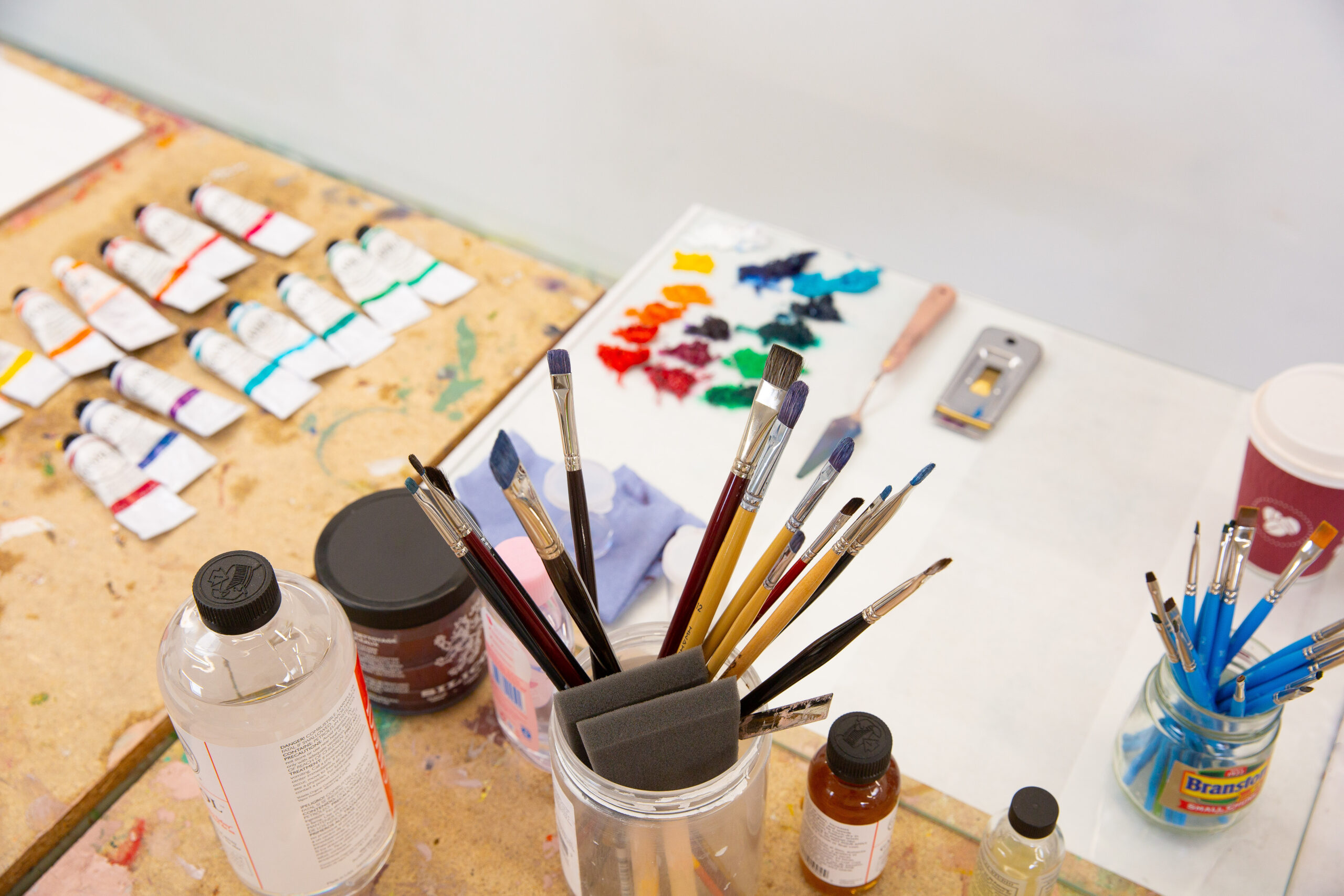
DM: When you explore quite extreme alternative palettes it can be difficult to imagine exactly how a heavy tonal decision will affect the other colours, the overall atmosphere. Did the digital preparation techniques assist in finding exactly how the blue should be deployed, and how it would interact with all the other parts of the spectrum that you’re using?
XW: Yes, well I usually make several versions and see what happens, before deciding on a final decision in a painting.
DM: These blue and indigo shades really enhance the sense of magic and mysticism in the painting, like we’re in a secret world or a different dimension. The tone really helps create this otherworldliness. When you look at the characters and their expressions however, there is this sense of tension, and you get the feeling that this isn’t actually a very comfortable place where these are set.
XW: I have been very interested in the idea of something being uncanny since grad school, it’s always been fascinating to me. One of the things I’ve been trying to do in my paintings with this colour palette is to achieve the uncanniness. A lot of people when they look at my paintings they mention this feeling of not being not sure what time it is, or where it is. And that’s the kind of thing I’m trying to do with my painting, trying to give you this ambiguous and vaguely ominous feeling, but you’re not really sure of it.
DM: Yes, that’s how it feels looking at your work.
XW: Recently I’ve been digging a little bit deeper into this. When colour palettes are distorted like this and they put you into this uncanny area, and I think about this with my interest in Romanticism. I’m interested in creating the feeling of a higher spirituality, if you will, that is not religious in any way. But there’s this will to look for something that is higher but you’re not really getting there.
DM: There are many ways to depict or even evoke the sensation that there is this higher spirituality, and various means by which you can access it. The thing that makes your work powerful for me personally, is that I can feel this within it. The darkness of it though makes me think of sleep paralysis, not sure if you’ve experienced that particular discomfort.
XW: Not personally, but I will tell you that one of my favourite artists in general is David Lynch. A lot of the way that I create these strange feelings in my work is learned from how he does that in his film works. Obviously translating into painting means considering a completely different medium, but that’s something I’ve always had an interest in doing.
DM: It really strikes me how the atmosphere of your work is similar to certain aspects of his films, which for me have a similar hypnagogic tension to sleep paralysis – which is what I was getting at. The general tone is that there’s a sense of psychological discomfort but you can’t really be sure exactly why. With Inland Empire or Mulholland Drive in some scenes there’s something just not quite right at all, and you’re left guessing for a very long time about why you feel so uncomfortable. And similarly your work gives just enough to make the viewer feel like something’s not quite right, something is deeply emotional, but in a very abstract way. But you don’t give all the answers and the work then retains a level of intrigue and mystery that makes it so fascinating.
XW: One of the things that I find very fascinating about Lynch’s film work is that every scene that he does is extremely specific – the dialogue, props and the plot. Every moment is very, very specific and leads you to this weird, unfamiliar feeling. I feel like that’s something that is very important in my work too. Every element in the painting, you can tell exactly what they are, and I’m very serious about the figures in my paintings – they are real people from my life and I know them personally. I never liked painting people I don’t know and I don’t make up any characters.
DM: Talking about this actually brings me to another point, which is the potential use of humour in your work – it’s another shared aspect with Lynch, who can work this bizarre absurdity even into the most serious of sequences. In the way your figures can be positioned or how their facial expressions can be read, should we be feeling at all amused?
XW: Humour is not exactly how I would describe it, but I’m totally open to humour coming across and I’m very aware of what you’re talking about. Something I actively avoid in my painting is to tell you exactly what’s going on. I put these people in the painting in a situation but I never actually want them to do anything to help you figure out a narrative to the painting, or what it’s about.
DM: Yes, and it’s up to the individual if they want to respond to that with their own sense of humour or not. The idea of the absurd is much more interesting, and with the way you do it has an almost Dada tone to it, like you’ve captured some piece of abstract performance art or something like that. Although you don’t go to great lengths to communicate a narrative, I do feel like the sense of emotion and drama is very pronounced in your work, even if it’s not so simple to rest on an idea of what the emotion and drama could be about. It’s a magnificent thing to be reminded how it’s possible to achieve that with paint.
XW: Thank you. Not to constantly stay on the topic of David Lynch, but the way he would achieve a sense of a high emotion is through contrasts. A contrast between these extremely long, almost frustrating sequences that you have to sit through, and relatively little narrative it tells. Through that you concentrate on the sensations and amplify them, you really feel something at the end and you have to earn it; you can’t just have it given to you right away because that would be cheap. I don’t really want my painting ever to be overly dramatic because that will make the emotion sort of cheap. So I’m always creating something really subtle so you have to think ‘what is it?’ and you arrive at something eventually.
DM: So there’s this journey, and it’s more like you spend time with your mind slowly opening towards an idea or a conclusion, but it takes time.
XW: Yeah, but you have to suffer!
DM: Yes, it’s an ordeal to go through.
XW: Exactly.
DM: Can you tell me about your interest in improvised comedy? It’s amusing how you paint such meticulous and intricate paintings but are drawn to something more… chaotic.
XW: I’m a very organised person in the studio, everything I do is planned, so it’s nice to be entertained by something that is totally in the moment. Life is contradictory.
DM: Yeah, absolutely, and in fact this opens a point about the contradictions and contrasts that enrichen the situations you paint.
XW: Most of the effects in my paintings are achieved through contrast – from ideas, all the way to every detail, the applications of every patch of colour, it’s always through contrast. If there’s a patch of, for example, red that is really bright, it has to be contrasted by a patch of colour next to it that is very far from whatever that is. If I don’t do that in my paintings then they will look completely different.
DM: How much of that for you is intuitive? Do you refer to any kind of colour theory or anything like that or do you just feel out what you need to do?
XW: It’s about how contrast creates drama, with lighting in the scenes, and with colours and spaces, or even with narratives. Every aspect of my paintings has something to do with thinking from the perspective of contrast, and how to maximise the contrast. Colour theories have to serve that purpose.
“One of the things I’ve been trying to do in my paintings with this colour palette is to achieve the uncanniness.”
DM: The consistency over a body of work seems to rest on your intuition in this respect, the perhaps unconventional choices you might make when pairing colours to achieve that layering and depth, and the world of your paintings.
XW: I don’t think you have to know colour theory to be affected by the colour that you see. I don’t want to give homework to the viewer. They should be able to feel something right away without having to know how to study it.
DM: I think that is largely the case – I find it very easy to find myself in the kind of surreal and dreamlike space that your paintings appear to sit within, and that isn’t really based on any kind of academic process.
XW: A very direct example I can give is Edvard Munch, who is a major reference recently, though I think you probably wouldn’t be able to tell as it’s referenced in a very subtle way. I feel that I connect with his school of Expressionism because I’ve been through an academic education and then I had to learn to undo a lot of that. Part of that process is finding my own expressions and learning to be ok with showing them. When you look at Munch’s work you can really see that he shows you who he is unreserved and you receive them in the same way, and that triggers something in you.
DM: He paints in a way that connects primarily to your passive psychology and somehow bypasses the rational brain, which will scrutinise why the sky, for instance, is a colour that it could never possibly be, why a bridge is pink. It doesn’t matter if something makes no sense if it feels significant enough.
XW: Yeah exactly. It’s the kind of painting that when you look at it you sort of give up on yourself, you accept the world of these paintings first, then you think within this framework. Versus looking at them and thinking from a critical or conceptual point of view. So when looking at certain paintings of Munch the first thing that happens is that you get swallowed by these sensations, and you accept that. Then you can talk about unpacking them later.
DM: Talking about paintings existing in their own world, I feel like I should ask more about your world. With yours it feels like they are all taking place in the same reality and you are kind of extracting scenes from there. Or do you not see the work like that?
XW: I’m not that interested in repeating any of the same composition or imagery. After I’ve done something I usually move on from it very quickly and I try not to do the same thing again. So unless I make something as a miniseries or a pair each piece is quite different. But I am conscious of building this sense of another world.
Words by Daniel Mackenzie
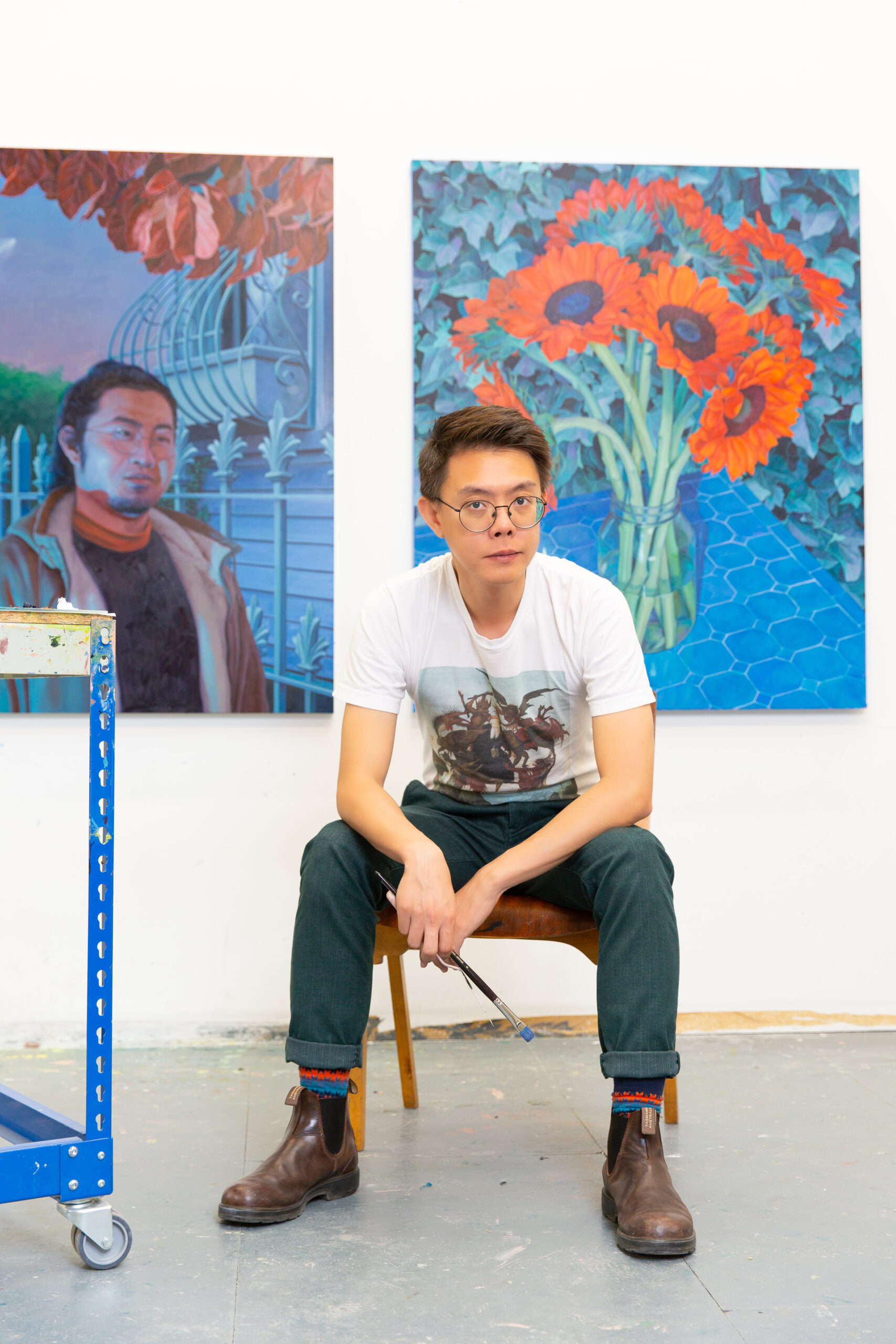
Xiao Wang
14th July–19th September, 2023
Tuesday–Saturday 9:30am–6:30pm
PM/AM (Gallery 2), 37 Eastcastle Street, London W1W 8DR
